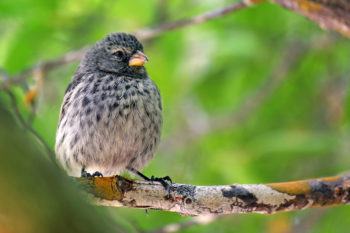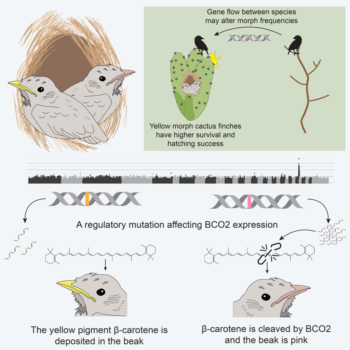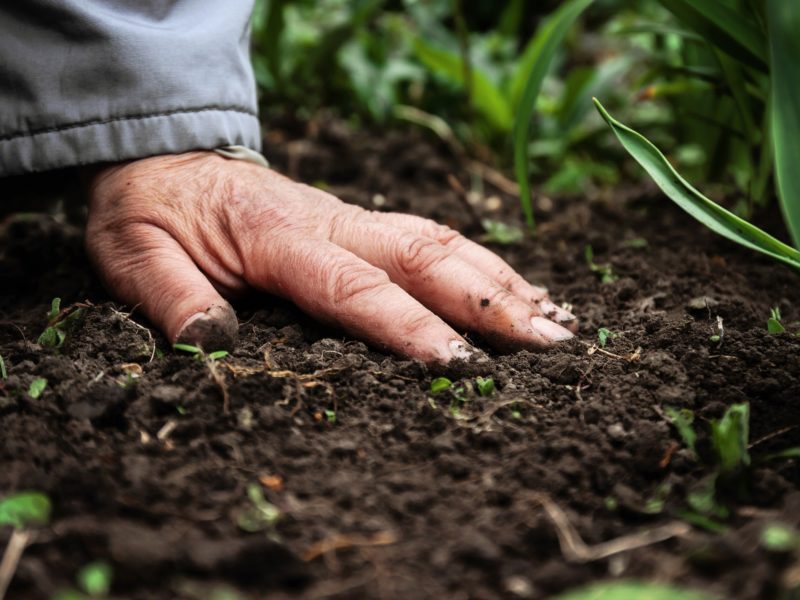Texas A&M Researcher Discovers Why Darwin’s Finches Have Different Beak Colors

Dr. Leif Andersson, a professor at the Texas A&M College of Veterinary Medicine & Biomedical Sciences (CVMBS) and Uppsala University, and researchers from Uppsala and Princeton universities have uncovered the genetic basis for the yellow beak color of some Darwin’s finch nestlings.
Several species of Darwin’s finch nestlings have a beak color that is either yellow or pink. An unusual feature of the Darwin’s finch beak color is that it is only visible before birds leave the nest; as adults, the beaks of most Darwin’s finches are entirely black due to deposition of melanin.
In their study, published in Current Biology, the researchers tie this beak-color variation to the carotenoid-rich diet consumed by the parents; they believe this finding may provide clues for how differences between species evolve.
Carotenoids form the basis for the colors red, yellow, and orange and are the underlying pigment for much of the enormous variety in color found across birds; in their study, the team discovered a mutation affecting the expression of a key carotenoid pigment gene, which results in carotenoids deposited at a greater rate in the beaks of birds possessing the mutation, leading to the observed yellow color.
Birds are not able to produce carotenoids themselves and obtain them by eating foods that contain carotenoids, such as insects and plants. In fact, much of the variation in beak, leg, and feather colors that can be observed among bird species is due to carotenoids.
The genetic basis for this variation has been poorly understood because there are millions of genetic differences between species and it is really difficult to figure out which ones control the difference in carotenoid pigmentation, according to Andersson.
“It is in fact more difficult than finding a nail in a hay stack,” he said.

However, when variation occurs within species, researchers can use modern genetic tools to identify the variation in DNA sequence that is controlling the difference in the visible phenotype.
By sequencing the full genome of hundreds of birds with yellow (with carotenoids) and pink (lacking carotenoids) beaks, the researchers found that the only consistent difference was a single base change in the protein-coding gene BCO2 (Beta-Carotene Oxygenase 2) that causes carotenoid oxidation (breakdown).
“It’s a really interesting gene that degrades a certain type of carotenoid. The finches that have the genetic mutation we identify express this gene at a lower amount, leading to the yellow carotenoid pigment being deposited in the beak,” said Erik Enbody, a postdoctoral fellow working in Andersson’s lab at Uppsala University.
“The mutation is present across species of Darwin’s finches on the Galápagos Islands, which allowed the researchers to identify the origin of the mutation approximately 500,000 years ago. This means that the mutation controlling beak color predates the origin of many present-day Darwin’s finch species.
The researchers used samples collected by Peter and Rosemary Grant at Princeton University to track the beak color variation in Darwin’s finches across 40 years on a small island in the Galápagos.
The Grants suspected that the prevalence of this mutation was impacted by a variety of factors, such as the amount of carotenoids in a population’s diet.
“We found that the beak color of the cactus specialist finch, the Common Cactus Finch, varies with the availability of cacti on the island,” they explained. “As carotenoids are present in the pollen and nectar of Opuntia cactus flowers, which the cactus finches consume, they may influence how common the yellow beak color is in nestlings.”
They also hypothesize that finches carrying the yellow beak mutation have a higher hatching success due to the increased carotenoids in their eggs’ yolk.
“It is important to notice that the metabolism of carotenoids has important implications because the degradation of carotenoids leads to the release of Vitamin A,” Andersson said. “Thus, storage of carotenoids in the beak and skin for subsequent release may be beneficial for health. It is interesting that the yellow gene variant has a high frequency in the Common Cactus Finch, a species that feeds on pollen and nectar from Opuntia cacti that is particularly rich in carotenoids.”
“Variation within species may provide clues for how differences between species evolve, and these findings in Darwin’s finches suggest that the selective advantage of presence/absence of carotenoid pigmentation may be related to diet,” Enbody said.
Media contact: Jennifer Gauntt, 979-862-4216, jgauntt@cvm.tamu.edu





